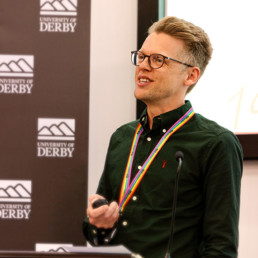
Written by Dr Adam Brett
Adam has completed a doctorate exploring the experiences of LGBT+ secondary teachers. A presentation of his findings can be found here. He also co-hosts a podcast called Pride and Progress, @PrideProgress, which amplifies the voices of LGBT+ educators, activists and allies.
“Children who need to be taught to respect traditional moral values are being taught that they have an inalienable right to be gay”
– Margaret Thatcher, October 1987.
Thanks for that, Margaret. You and your government created a culture of fear, silence and moral panic surrounding LGBT+ lives that continues to this day. Your speech continued, that “all of those children are being cheated of a sound start in life – yes, cheated!”.
She was right about one thing. Section 28 meant children were being cheated of a sound start in life.
Section 28 cemented schools as heteronormative spaces, where being heterosexual and cisgender were silently assumed, leaving LGBT+ people with the impossible decision or whether to be invisible or hyper-visible.
What a choice to have to make.
Do I hide my authentic self to fit in with the legislated normativity of schools, or do I make myself visible and put myself at professional and personal risk?
Patai (1992) refers to this form of hyper-visibility as ‘surplus visibility’, where a person is ‘extrapolated from part to whole’ and seen to represent the entirety of a minority group.
You might be thinking that a lot has changed since the repeal of Section 28 nearly 20 years ago in England. It’s true, a lot has changed and there has been significant cultural and legislative improvements for LGBT+ people. However, schools remain stubbornly heteronormative and cisnormative environments.
Think about the aspects of school that are predicated on a static, binary gender. Toilets; changing rooms; sports; gendered language; uniform; seating plans; residentials. The list goes on. What does this communicate for those who cannot or will not fit into the neat binary of male or female? That they don’t belong.
We could consider similar examples about the ways in which heteronormativity is maintained as the social order in schools. The curriculum; ethos; culture; policies; microaggressions; homophobia; the hidden curriculum; role models.
We can conceptualise all these examples as code.
I love to use the film The Matrix as a metaphor to explain the ways in which socially constructed ideas such as heteronormativity are held in place. When we are plugged into the matrix, we believe it’s real and can’t see the code that is continually constructing it. We can’t imagine alternatives as it’s all there is, in the same way that we can’t think outside of language.
However, when we develop the critical awareness of what is upholding this normativity and develop a language to name it, we become unplugged. LGBT+ people have the critical awareness to identify the ways in which schools seek to include or exclude them. Section 28 plugged us into a matrix of understanding where the silent assumption of cisgendered heterosexuality was so entrenched, that to this day, being an LGBT+ person in school can be a point of constant navigation and information management. Exhausting.
As educators and leaders, we need to listen to the lived experiences of our LGBT+ students and colleagues to create a culture, curriculum and language which can disrupt this code. We need to name things as heteronormative; we need to name things as cisnormative; we need to name things as microaggressions. We need a new language: one that allows us to think outside of the current heterosexual matrix. We need to create schools and spaces where LGBT+ people feel safe and included, without attracting surplus visibility.
Section 28 cheated a whole generation of LGBT+ young people out of a sound start in life. It’s time to unplug the matrix and make sure it doesn’t happen to the next generation.
Adam Brett
@DrAdamBrett

